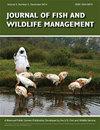佛罗里达州带帽蝙蝠在其活动范围北部的占用模式
IF 0.9
4区 环境科学与生态学
Q4 BIODIVERSITY CONSERVATION
引用次数: 0
摘要
佛罗里达帽蝠是一种罕见的佛罗里达南部特有的蝙蝠,栖息在啄木鸟的洞穴和人为的结构中,如屋顶瓦片、烟囱和蝙蝠屋。最北部出现的帽蝠来自佛罗里达州埃文公园空军靶场的成熟松林。我们使用超声波声波记录仪来了解帽蝠的活动和栖息地占用情况。我们使用层次贝叶斯分析对入住率建模,并包括地点和时间特定的检测概率协变量,以及地点特定的入住率协变量。在整个Avon Park空军靶场,发现的概率很低,但随着儒略历日期的增加而增加。在大多数生境中,除了平木成熟松林的入住率较低(0.23±0.06)外,其余生境的入住率均较低。随着与红冠啄木鸟种群距离的增加,占用率降低(β = -1.19±0.26 SD)。在范围的最北端,以及整个历史范围的大部分地区,增加成熟的、有火保护的森林系统的面积,将增加帽蝠的栖息地,并导致更快的种群恢复。本文章由计算机程序翻译,如有差异,请以英文原文为准。
Patterns of Florida Bonneted Bat Occupancy at the Northern Extent of Its Range
The Florida bonneted bat Eumops floridanus is a rare, endemic bat of south Florida, which roosts in woodpecker cavities, and anthropogenic structures, such as roofing tiles, chimneys, and bat houses. The northern-most occurrences of the bonneted bat are from mature pine forests at the Avon Park Air Force Range, Florida. We used ultrasonic acoustic recorders to understand bonneted bat activity and habitat occupancy. We modeled occupancy using a hierarchical Bayesian analysis, and included site- and time-specific covariates of detection probability, and site-specific covariates of occupancy. Probability of detection was low throughout Avon Park Air Force Range, but increased with Julian date. In most habitats, occupancy was poorly estimated, except for flatwood mature pinelands where occupancy was low (0.23 ± 0.06). As distance from red-cockaded woodpecker colonies increased occupancy decreased (β = -1.19 ± 0.26 SD). At the northern-most extent of the range, and throughout much of the historic range, increasing the expanse of mature, fire-maintained forest systems will increase habitat for the bonneted bat, and lead to faster population recovery.
求助全文
通过发布文献求助,成功后即可免费获取论文全文。
去求助
来源期刊

Journal of Fish and Wildlife Management
BIODIVERSITY CONSERVATION-ECOLOGY
CiteScore
1.60
自引率
0.00%
发文量
43
审稿时长
>12 weeks
期刊介绍:
Journal of Fish and Wildlife Management encourages submission of original, high quality, English-language scientific papers on the practical application and integration of science to conservation and management of native North American fish, wildlife, plants and their habitats in the following categories: Articles, Notes, Surveys and Issues and Perspectives. Papers that do not relate directly to native North American fish, wildlife plants or their habitats may be considered if they highlight species that are closely related to, or conservation issues that are germane to, those in North America.
 求助内容:
求助内容: 应助结果提醒方式:
应助结果提醒方式:


